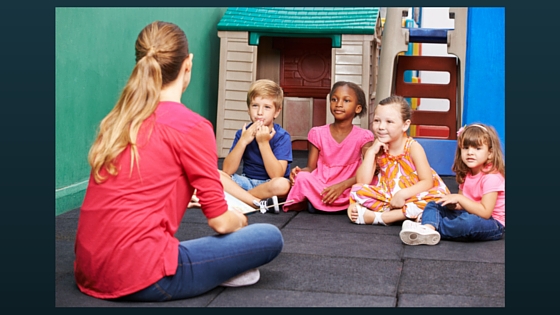The Hottest Show In Town: Storytime @ your library

What’s happening when The New York Times has been reporting queues as long as those for hot Broadway shows like Hamilton? And there are lines circling city blocks for hours waiting for tickets for first-come, first-serve seats? Storytime at one of New York City’s many public libraries. Library storytimes have been drawing record crowds in New York City and around the country since the White House released its report, Empowering Our Children—Bridging the Word Gap, in June 2014. So what exactly is driving this surge?
Children from low income communities use an average of thirty million words less than their affluent counterparts and experience a “drought in heard words” by age three, putting them at a huge language disadvantage long before they even enter school.[1] Early language development is vital to early literacy skills. Verbal interaction with a baby can have a huge positive effect on language development. Whether a parent or caregiver talks, sings, or reads, “neural connections of all kinds are strengthened with the baby’s rapidly growing brain.”[2] New and improved storytimes are addressing these needs.
Library storytimes traditionally focused entirely on children—now, they focus on family literacy and modelling strategies that parents can use to develop early literacy skills. Today’s storytimes emphasize education as much as entertainment and offer suggestions for re-enforcing key concepts and skills at home. Sara Feldman, president of the American Library Association, said, “Such early-literacy efforts are part of a larger transformation libraries are undergoing to become active learning centers for their communities—offering services like classes in English as a second language, computer skills, and career counseling”.[3]
The Public Library Association (PLA) and Association for Library Service to Children (ALSC) concluded that a dual approach, early literacy and parent/caregiver education, would provide maximum benefits: “If the primary adults in a child’s life can learn more about the importance of early literacy and how to nurture pre-reading skills at home, the effect of library efforts can be multiplied many times.”[4] So, it’s no wonder that parents of the under-five set are competing for the limited number of seats at storytime at their public libraries. If, as current research suggests, there is a “word gap” between low income families and middle/higher income families, then New York City’s five borough ‘s public libraries, The New York Public Library, Brooklyn Public Library and Queens Library, are certainly trying to fill in that gap.
The New York Public Library just added forty-five children’s librarians to support storytime and designated twenty of its eighty-eight neighborhood branches as “enhanced literacy sites”—they will offer storytime as often as four times a week and distribute fifteen thousand “family literacy kits” that include a book and storytime schedules. In Queens, forty-one library branches are adding weekend story times to meet the demand. In Manhattan, the 67th Street branch holds storytime outdoors during the summer when it can have as many as two hundred people. And in Brooklyn, some branches distribute tickets to storytime because of space and popularity. Unlike other New York events, the libraries have yet to see storytime scalpers. City-wide, storytime attendance rose to 510,367 people in fiscal year 2015, up nearly 28 percent from 399,751 in fiscal 2013.
Other efforts in this arena include:
- ALSC has launched Babies Need Words Every Day: Talk, Read, Sing, Play, which provides shareable resources for parents to bridge the thirty million word gap. Eight visually appealing posters (available in English and Spanish) deliver simple, effective rhymes, games, and other suggestions for parents to communicate with their babies. ALSC also provides a recommended list of books.
- United for Libraries sponsors Books for Babies, a national literacy program that provides parents of newborns with a kit containing a board book for baby and baby’s first library card. Most importantly, the kits (in English or Spanish) emphasize the important role parents play in a baby’s early language development and reading tips and information from nationally-recognized educational organizations.
- The PLA/ALSC initiative, Every Child Ready to Read @ your library (ECRR) was published in 2004 and has updated and expanded to a second edition in (2011). Teaching parents and other caregivers how to support the early literacy development of their children is the basis of Every Child Ready to Read @your library®.[5]
“It is clear that reading and being exposed to books early in life are critical factors in student success,” Anthony W. Marx, president of The New York Public Library, said. “The library is playing an increasingly important role in strengthening early literacy in this city, expanding efforts to bring reading to children and their families through quality, free story times, curated literacy programs, after-school programs and more.”[6]
References:
[1] Maya Shankar. “Empowering Our Children by Bridging the Word Gap,” The White House [Blog], June 25, 2014. Retrieved January 28, 2016.
[2] Ibid
[3] Winnie Hu. “Long Line At the Public Library,” The New York Times, November 1, 2015. Retrieved January 28, 2016.
[4] Every Child Ready to Read @ your library: Read, Think Grow. Retrieved January 28, 2016.
[5] Every Child Ready to Read @ your library: Read, Think Grow. Retrieved January 28, 2016.
[6] Winnie Hu. “Long Line At the Public Library,” The New York Times, November 1, 2015. Retrieved January 28, 2016.
Resources:
Order/download free ALSC posters.
ALSC’s talking points for librarians
Tags: early childhood literacy, early literacy activities, New York Public Library, nypl, storytime







